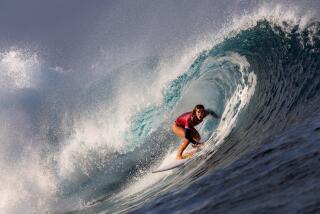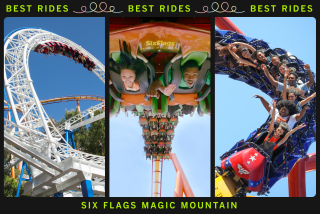Snowboarding: Making Waves on the Slopes
- Share via
WRIGHTWOOD — Australia’s Gary Elkerton had just finished winning a preliminary heat during a surfing contest last summer in Huntington Beach, but his mind was in the Alps.
“Snowboarding is an excellent sport,” said Elkerton, the second-ranked surfer on the Assn. of Surfing Professionals tour. “It’s pretty easy for a surfer to catch on to and it’s something real fun for us to do in the winter.”
Terrific.
Just what your favorite ski resort needs, longer lift lines and a bunch of gnarly surf dudes shooting down your favorite chutes.
What’s next? Skateboarding on the cart paths at Augusta National?
You slide to a stop at the side of a pristine trail bordered by towering pines standing majestically like so many snow-dusted palace sentries. Leaning on your poles, you take a deep breath, hoping to capture a lungfull of tranquility.
Suddenly, the spell is shattered by a nails-on-a-blackboard grinding as the edge of a snowboard skids across the slope. There’s a flash of neon colors and you’re left with the image of a crouched figure, silhouetted by a wake of spraying snow as he banks out of a sweeping turn.
In his mind, no doubt, he was blasting off the lip of a 10-foot tube at the Pipeline.
In between curses, though, even the most dyed-in-the-ski-sweater-wool traditionalist has to admire the flowing, graceful lines of snowboarding.
You might pine for the good old days of the early ‘80s, when they banned these things from most ski resorts, but in the back of your mind, you’re saying, “It does look like fun.”
At least that was my view of snowboarding . . . until recently, that is, when my feet were affixed to one of those five-foot pieces of wood and fiberglass and I stood at the top of Chair No. 4 at Mountain High West in Wrightwood, staring down a run called “Chisolm.”
Clearly, it was a new perspective. The sign said, “Easiest Way Down.” I wasn’t buying it.
This, of course, was after a few runs down the bunny slopes with an instructor and an hour of training, during which one of the axioms of learning to snowboard becomes intimately clear: There is no easy way down.
At least there’s no easy way to fall down.
This is one of the few sports that isn’t too hard on your knees. With both feet strapped in, the knees are relatively safe. Snowboarding doesn’t provide much work for the arthroscope folks, but it does wonders for the plaster business.
Falling off a snowboard is like being pushed out of a moving car with your shoelaces tied together. A lot of arms and wrists get broken while attempting to break falls.
Still, with a couple of decades of surfing experience and enough time on skis to take on the majority of ski runs, I approached snowboarding with only a bit of apprehension. After all, there appeared to be just two risks: serious injury and total self-abasement.
One out of two ain’t bad. No bones were broken.
Heck, it only took 15 minutes to master buckling the bindings without help. And what’s embarrassing about spending an entire day with the seat of your ski pants soaking wet?
I bowled over just one lift attendant when dismounting Chair No. 2. (“Don’t worry,” he said, managing a smile, “I’ve been run over by bigger guys.”) Somehow, that didn’t make me feel much better.
But the ultimate humiliation was waiting a few hundred yards down Chisolm.
After several semi-controlled turns across the slope, I found myself almost able to relax. “Gee, I’m almost shredding.”
Then the downhill edge of the board bit into the snow and I found myself airborne. Head over heels. Heels over head.
At some point, the bouncing stopped and the hurting started. Everything, it seemed, was bruised . . . ego included, thanks to a little girl of about 7 or 8, who was wearing hot pink ear muffs and sunglasses to match.
She snowplowed to a stop a few feet away. “You should watch where you’re going,” she said and set off down the hill.
That pretty much sums up the way most skiers feel about snowboarders, especially those who have complete control of their boards and use it to terrorize unsuspecting skiers by carving precariously close turns that shoot stinging sprays of snow.
“These guys pay the 35 bucks (for a lift ticket) like everyone else and there’s more and more of them every day,” said the assistant manager of one Southland resort who requested anonymity. “So most people (in the business) are trying to downplay the bad reputation they have.
“But a lot of them have earned that reputation. Snowboarders are the most obnoxious, rude and dangerous people on the hill. I know a girl who has two steel pins in her arm because some jerk snowboarder plowed into her and then split. The police are treating it as a hit-and-run accident.”
More than 250,000 people have taken up snowboarding in the last three years, swelling the ranks to an estimated 400,000. And the snowboard industry is booming with technical advances making the sport more accessible every month.
Resort owners now welcome snowboarders with open arms. After all, they are mostly new customers. Surveys show that about 80% began snowboarding without prior skiing experience.
In some factions of the snowboard industry, there’s a move afoot to change the name of the sport to “ski boarding,” an attempt at changing the image as well. But as long as the sport attracts mostly aggressive young males who are the scourge of the hill, they’ll be forever referred to by skiers as “boardheads.”
“A lot of the (snowboarders) that we get up here come right off the beach,” said Michael Burian, a ski and snowboard instructor at Mountain High. “There is definitely a certain courtesy lacking. They’re used to having to fight for waves.
“But I see them changing as they begin to realize the expectations. They’re not used to waiting in lift lines, either, but they’re also not used to riding a 20-minute wave that’s always going to be there every time they get off the lift.”
Burian was born in Czechoslovakia and grew up skiing in Switzerland and Austria. He moved to the San Fernando Valley as a teen-ager and became an avid surfer, spending every spare moment on the beach at Malibu.
Eight years ago, he saw a couple of guys testing a prototype snowboard on the slopes at Mountain High. The two worked for Tom Sims, who is credited with inventing the snowboard in 1975, and they gave Burian a board to try out. He has been a fan ever since.
Burian has seen snowboarding evolve from outlaw status to big business. He understands that snowboarders often live up to their ignominious reputation. “But they’re probably not that much worse, in general, then their same-age group of skiers,” he said.
The majority of snowboarders are young (18-25) and male. Burian said more females are signing up for classes--”We even get some moms with their kids”--but middle-aged men don’t seem so eager to give up their competency on skis to become neophyte snowboarders.
Elkerton said the rift between skiers and snowboarders exists in part because most skiers don’t understand the essence of the problem. Skiing and snowboarding are different sports that simply have to share the same medium: a ski slope.
“Skiers use a series of quick turns for control, but they take a basically straight track down the hill,” said Elkerton. “We’re carving from side to side, looking to make re-entries off the side walls of the run.
“It can be hectic. We have to weave through these people and they’re a bit dangerous, you know.”
Three years ago, Gary Elkerton’s brother-in-law took him to a ski resort in the Alps. They rode up the lift to the top of the mountain. Elkerton, who had never skied, stood at the top and looked down.
“Basically, he just tied me into a snowboard and pushed me off the top,” Elkerton said. “I’m not afraid of 20-foot waves, but when you’re looking down a 1,300-foot black diamond (most difficult) run, it’s different.
“Sure, I had trouble at first and I ran a few people down in the process. But by the end of the second day, I was going good. Of course, I was taking a bath in Tiger Balm every morning and every night.”
Too many beginning snowboarders are self-taught or buddy-taught and very few possess the athleticism of Elkerton. In many cases, it’s just a matter of waiting for the accident to happen.
Novice snowboarders soon learn that it’s easier to do when you’re going fast; it’s also much easier to get hurt.
“Snowboarding is a lot faster than surfing,” Elkerton said. “You make your maneuvers at a much greater speed. When I get back in the water after snowboarding, it seems like everything’s in slow motion. I think it helps my surfing a lot. It makes me feel more powerful.”
The only real way to understand a snowboarder’s point of view, of course, is to strap on a snowboard. And there probably are a lot of skiers who have no desire to pay the price for a different perspective.
“It takes an aggressive, no, heroic commitment to learn to snowboard,” Burian said. “You’re either standing. Or you’re not standing.”
And most beginners are prone to be prone.


